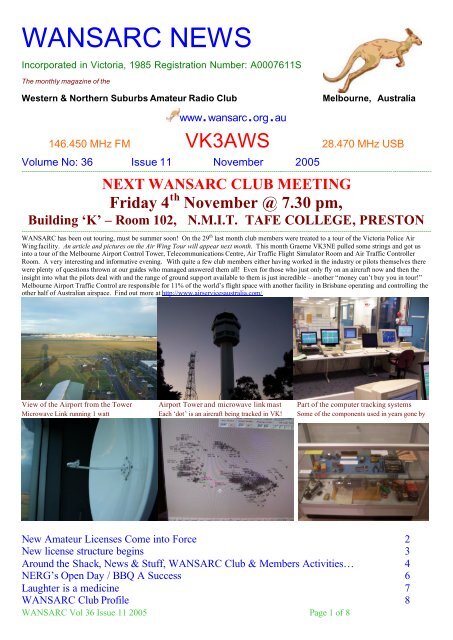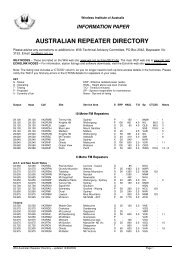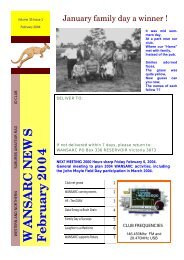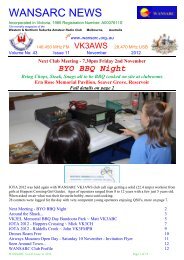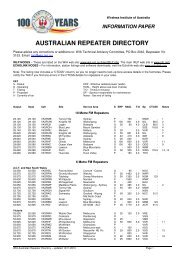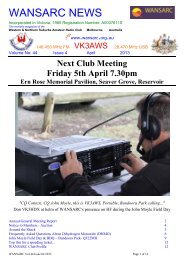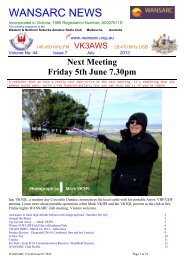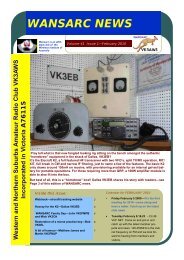WANSARC Vol 36 Issue 11 2005.pdf - Western & Northern Suburbs ...
WANSARC Vol 36 Issue 11 2005.pdf - Western & Northern Suburbs ...
WANSARC Vol 36 Issue 11 2005.pdf - Western & Northern Suburbs ...
Create successful ePaper yourself
Turn your PDF publications into a flip-book with our unique Google optimized e-Paper software.
<strong>WANSARC</strong> NEWS<br />
Incorporated in Victoria, 1985 Registration Number: A00076<strong>11</strong>S<br />
The monthly magazine of the<br />
<strong>Western</strong> & <strong>Northern</strong> <strong>Suburbs</strong> Amateur Radio Club<br />
Melbourne, Australia<br />
www.wansarc.org.au<br />
146.450 MHz FM VK3AWS 28.470 MHz USB<br />
<strong>Vol</strong>ume No: <strong>36</strong> <strong>Issue</strong> <strong>11</strong> November 2005<br />
----------------------------------------------------------------------------------------------------------------------------------------------------------------------------------------------------------<br />
NEXT <strong>WANSARC</strong> CLUB MEETING<br />
Friday 4 th November @ 7.30 pm,<br />
Building ‘K’ – Room 102, N.M.I.T. TAFE COLLEGE, PRESTON<br />
----------------------------------------------------------------------------------------------------------------------------------------------------------------------------------------------------------<br />
<strong>WANSARC</strong> has been out touring, must be summer soon! On the 29 th last month club members were treated to a tour of the Victoria Police Air<br />
Wing facility. An article and pictures on the Air Wing Tour will appear next month. This month Graeme VK3NE pulled some strings and got us<br />
into a tour of the Melbourne Airport Control Tower, Telecommunications Centre, Air Traffic Flight Simulator Room and Air Traffic Controller<br />
Room. A very interesting and informative evening. With quite a few club members either having worked in the industry or pilots themselves there<br />
were plenty of questions thrown at our guides who managed answered them all! Even for those who just only fly on an aircraft now and then the<br />
insight into what the pilots deal with and the range of ground support available to them is just incredible – another “money can’t buy you in tour!”<br />
Melbourne Airport Traffic Control are responsible for <strong>11</strong>% of the world’s flight space with another facility in Brisbane operating and controlling the<br />
other half of Australian airspace. Find out more at http://www.airservicesaustralia.com/<br />
View of the Airport from the Tower Airport Tower and microwave link mast Part of the computer tracking systems<br />
Microwave Link running 1 watt Each ‘dot’ is an aircraft being tracked in VK! Some of the components used in years gone by<br />
New Amateur Licenses Come into Force 2<br />
New license structure begins 3<br />
Around the Shack, News & Stuff, <strong>WANSARC</strong> Club & Members Activities… 4<br />
NERG’s Open Day / BBQ A Success 6<br />
Laughter is a medicine 7<br />
<strong>WANSARC</strong> Club Profile 8<br />
<strong>WANSARC</strong> <strong>Vol</strong> <strong>36</strong> <strong>Issue</strong> <strong>11</strong> 2005 Page 1 of 8
New Amateur Licenses Come into Force<br />
At the first moment of Wednesday 19 October 2005 the new Australian amateur license structure came<br />
into force.<br />
At that time, the Determination made by the Australian Communications and Media Authority<br />
amending the Amateur License Conditions Determination became the law.<br />
What does it mean<br />
It means that as from that time the Foundation license exists, and we hope that the first Foundation Licenses will be<br />
issued by the end of that week, to those who qualified at the trial Foundation training course conducted by the Gold Coast<br />
Amateur Radio Society on the weekend of 15 and 16 October.<br />
The amateur Foundation licensee can only use a transmitter that has been manufactured commercially, can only<br />
use voice, on either SSB, AM or FM or Morse using a manually operated Morse key, and not more than 10 watts<br />
output power ssb or 3 watts output power AM, FM or CW.<br />
The Foundation station can operate on the 80, 40, 15 and 10 meter bands as well as the 2 meter band and the<br />
band 430 to 450 MHz, subject to necessary bandwidth restrictions.<br />
It means that the Standard license now exists, and this license includes the existing Novice, and Novice Limited<br />
licensees, who now can use any emission mode with a necessary bandwidth not exceeding 8 kHz on the 80, 40, 20 and<br />
15 meter bands, and any emission mode with a necessary bandwidth not exceeding 16 kHz on the 10 meter band, the<br />
band 52 to 54 MHz, the 2 meter band, and the bands 430 to 450 MHz, 1240 to 1300 MHz, 2,400 to 2,450 MHz and 5.650<br />
to 5.850 GHz, with no change to the current output power limits of 100 watts and 30 watts.<br />
It means that the Advanced license exists, and this license includes the existing Unrestricted license, the Limited license<br />
and the Intermediate license, who can use any emission mode with a necessary bandwidth not exceeding 8 kHz on all<br />
bands below 24.990 MHz, any emission mode with a necessary bandwidth not exceeding 16 kHz on the 28.00 MHz to<br />
29.70 MHz band, any emission mode with a necessary bandwidth not exceeding 100 kHz on the 6 and 2 meter bands<br />
and any emission mode with no bandwidth restriction above 420 MHz, and with no change to the current output power<br />
limits of 400 watts and 120 watts.<br />
Full details of the Determination and other administrative details including the arrangements being made by ACMA to<br />
substitute new licenses for existing licenses can be found at the ACMA website, www.acma.gov.au, and all amateurs are<br />
urged to check that site for the full and authorative information.<br />
The WIA welcomes the changes.<br />
WIA President, Michael Owen, VK3KI, said today “The WIA welcomes these long awaited changes, and in particular<br />
welcomes the new Foundation license, which we hope will encourage many newcomers to our exciting interest.<br />
We also know that there will be many amateurs operating on the 40 and 20 meter bands for the first time with those<br />
bands available to Standard licensees.<br />
We urge all amateurs to make all these newcomers welcome.<br />
The WIA would also like to acknowledge the cooperative approach of ACMA in establishing the new syllabi for the various<br />
licenses and the establishment of the new WIA assessment of competency system relying on WIA accredited and<br />
registered Assessors, essential for the practical assessment required for the Foundation qualification and, indeed, for any<br />
first amateur license.”<br />
“Our only regret is that we believe that the power limits of 3 watts for AM, FM and CW for the Foundation license,<br />
while perfectly logical, is unrealistic given the output power of commercially available equipment, particularly<br />
older equipment, and that the power limit should be 10 watts.<br />
The WIA has already drawn ACMA’s attention to this problem, and has requested that the limit be changed at the<br />
first opportunity.<br />
That apart, the WIA believes that these changes to the Australian amateur license structure will strengthen our hobby,<br />
and encourage many more people to become licensed radio amateurs.”<br />
If you were in any doubt that the WIA is an effective organisation then the new structure<br />
should leave you in no doubt of the Institutes ability to effectively negotiate on our behalf.<br />
The new conditions should please everyone, and all with no loss of privileges in any area.<br />
<strong>WANSARC</strong> <strong>Vol</strong> <strong>36</strong> <strong>Issue</strong> <strong>11</strong> 2005 Page 2 of 8
A bulletin to members from Amateur Radio Victoria New license structure begins<br />
Key points at a glance:<br />
• New license structure begins 19/10/2005<br />
• Expect new replacement licenses through the post<br />
• WIA rolls out the new Assessment for Competency<br />
• First group qualifies for their Foundation Licenses<br />
• Class License for short-term visitors – not yet<br />
The three tier amateur licensing system officially in force on Wednesday, 19 October, through an amendment<br />
to the Radiocommunications License Conditions (Amateur License) Determination.<br />
Approved by the ACMA Board on 12 October and announced 18/10/2005, it simplifies amateur licenses by<br />
combining the five current license types in two - Standard and Advanced. It also introduces the new entry level<br />
Foundation License.<br />
The first to qualify for the Foundation License under the WIA Assessment for Competency conducted by<br />
Accredited Assessors are now awaiting their licenses. Many more are expected in coming months.<br />
Due to an anomaly in the new LCD, the Foundation License has been given only 3-watts output power for AM,<br />
FM or CW, but 10-watts PEP for SSB. The WIA has raised this situation with ACMA and the intention is to<br />
increase the 3-watts to 10-watts.<br />
The ACMA says that all existing amateur licensees will be issued with new replacement licenses. Novice and<br />
Novice-Limited can on the commencement day use the Standard License operating privileges. However all<br />
licensees need to wait until they received their new license before seeking any changes such as to a call sign.<br />
Along with the new license structure comes the harmonizing of license conditions and qualification<br />
requirements, where possible, with those of other countries.<br />
This is resulting in a re-alignment of the theory syllabus to international requirements for the Standard and<br />
Advanced Licenses.<br />
The new Assessment for Competency system to determine the qualification of individuals for amateur<br />
certificates of proficiency was introduced on 14 October by the Wireless Institute of Australia.<br />
It was trialed in Queensland on the weekend of 15-16 October. That resulted in<br />
16 people, the youngest aged 10, are declared competent after their Foundation License assessment.<br />
The Assessment for Competency system through a network of WIA Accredited Assessors will be rolled out<br />
across the nation in coming weeks.<br />
The current WIA Exam Service Invigilators continue to have a role to play in conducting paper-based multichoice<br />
theory and regulations exams for the Standard and Advanced licenses. They can also team up with an<br />
Assessor and provide assistance to them.<br />
Only Assessors can conduct the Foundation License assessments and the practical assessments required for<br />
those who aren’t already radio amateurs who want to take get a Standard or Advanced license.<br />
The license restructure is one of the final actions for the ACMA to flow from its extensive public review of<br />
Amateur Service regulation that begun in August 2003.<br />
The first step was the removal of the Morse code proficiency requirement for access to the HF bands, and that<br />
occurred on 1 January, 2004.<br />
Likely to be the final matter implemented from the review is the introduction of a Class License for visiting radio<br />
amateurs.<br />
This is expected to begin before the Melbourne Commonwealth Games in March 2006 to enable duly qualified<br />
overseas radio amateurs to operate for short-term visits without the need to take out an Australian license.<br />
They will then be able to operate under their home call sign /VK*<br />
- Amateur Radio Victoria<br />
Foundation webpage<br />
www.amataeurradio.com.au/foundation<br />
<strong>WANSARC</strong> <strong>Vol</strong> <strong>36</strong> <strong>Issue</strong> <strong>11</strong> 2005 Page 3 of 8
Around the Shack, News & Stuff, <strong>WANSARC</strong> Club & Members Activities…<br />
WELCOME NEW MEMBER TO <strong>WANSARC</strong><br />
Welcome to our latest member, Brian VK3RA, from Preston.<br />
VK3ZCW NOTCHES UP 50 YEARS<br />
No, he isn’t 50, but talks like one at times! (hi) November 29th<br />
sees Max VK3ZCW celebrate 50 years as a licensed operator on<br />
the amateur bands. Well done Max, a great excuse for a scotch!<br />
Does this make Max <strong>WANSARC</strong>’s longest current ‘ticket’ holder<br />
Max is still heard nearly everyday around 16.00 local, on 146.450<br />
SPRING VHF-UHF FIELD DAY 2005<br />
John Martin VK3KWA, advises the dates are Saturday and<br />
Sunday November 12 and 13. Duration in all call areas other than<br />
VK6: 0100 UTC Saturday to 0100 UTC Sunday.<br />
Duration in VK6 only: 0400 UTC Saturday to 0400 UTC Sunday.<br />
Further details check with John Martin (VK3KWA), contest<br />
manager.<br />
SOME COMMENTS ON A.T.V. FROM Peter Cossins VK3BFG<br />
Have had a short read of the ATV article in the <strong>WANSARC</strong> 2005<br />
May edition, I offer a few comments;<br />
1. Re terminating coaxial cables. I was concerned to read<br />
discussion regarding preferred lengths of Teflon (or other) cable<br />
for terminating the exciters. If it is found that a specific length is<br />
more favorable than another, and then it is the terminating<br />
technique that is at fault, you can have any length of cable you<br />
like. (taking losses aside) The basic rules are as follows....<br />
(a) Keep the line as short as possible. (to reduce losses)<br />
(b) Terminate Teflon co-ax to a Type N (or a BNC or SMA)<br />
connector as shown in the pic. The end of the connector has been<br />
cut off to an absolute minimum length and the braid is sweated<br />
directly to the connector body. The inner connection is a short as<br />
possible.<br />
(c) Cut off the mounting screws to a minimum length. (mine are a<br />
bit long!!!)<br />
2. Antenna performance. Antennas are usually evaluated in terms<br />
of VSWR by Amateurs. Low VSWR = good antenna.<br />
There are two separate matches that need to be evaluated ...<br />
VSWR is one ... but antenna to free space is the other.<br />
The basic (simple) model for any antenna is Antenna Resistance =<br />
Radiation Resistance + Loss Resistance. The Antenna Resistance<br />
may be close to 50 ohms and hence the VSWR will be low. The<br />
Loss Resistance may be high and hence the antenna does not<br />
radiate well. The point I am making is that good VSWR does not<br />
necessarily mean good radiation. At the extreme end of this I could<br />
put a dummy load on the end of the co-ax, the VSWR would be<br />
great but signal reports will be minimal!!! (if any)<br />
This discussion does not take into account co-ax cable losses in<br />
actually measuring VSWR ......... that's yet another story.<br />
Both parameters need to be evaluated for assessing the<br />
performance of antennas ... low VSWR and good radiated field<br />
strength. Would offer to give a chat on these topics at a club<br />
meeting if you like. (Careful – we might just take you up on that! –<br />
Editor)<br />
3. The info on VK3RTV is very out of date. Unfortunately the<br />
website is not well maintained. (But the Repeater sure is!! – Ed.)<br />
Regards Peter Cossins VK3BFG<br />
(Thanks to Peter from your editor for the CD of his PowerPoint<br />
presentation on VK3RTV and ATV in general shown at the NERG<br />
Open Day & BBQ. Members of the public when told ATV can be<br />
picked up on a normal TV and transmitted legally by amateur radio<br />
operators were amazed! Our audience is growing after NERG bbq.<br />
Also thanks to our past club President, Grant VK3HFS, for the<br />
interview about <strong>WANSARC</strong>’s A.T.V. activity that went to air on the<br />
WIA broadcast. *** Peter VK3BFG also made the comment that<br />
going by number of ATV kits sold in Melbourne and actual on air<br />
ATV activity, it would seem only about less than 10% get built to<br />
completion and put up to “air”. To all those at <strong>WANSARC</strong> and<br />
NERG that bought ATV kits a while ago – come on and get those<br />
soldering irons out, lets turn that trend around!!***)<br />
MORE MEANINGFUL SIGNAL REPORTS<br />
The Readability, Signal Strength, Tone report or RST has been a<br />
part of radio operating since about 1934, but it's unsuitable for<br />
modern digital modes of transmission. A new signal measurement<br />
is being adopted. Move over RST, make room for RSQ. Graeme<br />
Harris VK3BGH and others in the United States and Britain have<br />
been advocating the use of a new reporting system for Phase Shift<br />
Keying (PSK), with Q standing for Quality, replacing T-Tone that is<br />
useful in Morse code operation. After the team worked on the<br />
concept for a few years, Graeme VK3BGH wrote an article for the<br />
WIA journal Amateur Radio magazine. This was picked up by CQ<br />
Magazine, and then caught the attention of OeVSV - the Austrian<br />
radio society. OeVSV in a successful motion at the recent IARU<br />
Region 1 Conference, we saw RSQ being unanimously accepted<br />
for recommended for use below 30MHz. Its paper to the<br />
conference said the use of the traditional RST system is almost<br />
meaningless for digital modes, while RSQ provides a reliable and<br />
accurate description digital mode signals such as PSK31, MFSK,<br />
RTTY, Pactor and others. Graeme VK3BGH says he's delighted<br />
at hearing news of the IARU Region 1 recommendation and looks<br />
forward to it being considered by the remaining two IARU regions<br />
in coming years. For PSK, Readability is the percentage of<br />
decipherable text, Strength is a visual measure of the waterfall<br />
trace, and Quality attempts to describe visible unwanted<br />
sidebands.<br />
ACMA approve ‘AX’ for Melbourne Commonwealth Games<br />
The Australian Communications and Media Authority (ACMA)<br />
have approved a WIA request for the use of the AX prefix to<br />
celebrate the 2006 Commonwealth Games in Melbourne.<br />
The AX prefix may be used by all Australian Radio Amateurs for<br />
the period 1 - 31 March 2006.<br />
CALLBOOK 2006 MAIL ORDERS NOW OPEN<br />
The Australian Radio Amateur Callbook 2006 is expected to be<br />
available through Amateur Radio Victoria by early November.<br />
Members are invited to place their mail orders now which will be<br />
dispatched immediately Callbook stocks arrive.<br />
The updated Callbook will have details of the new three license<br />
structure, details of exam invigilators and accredited assessors,<br />
the latest WIA Band Plans, a host of reference material plus a<br />
searchable CD.<br />
Mail orders to members:<br />
Cost $25.50 including post and packing (no increase from previous<br />
years c/book)<br />
You may order by mail, fax (9885 9298) or email, and payment<br />
can be made to Amateur Radio Victoria by cheque, money order<br />
or credit card (normal card details required).<br />
Over the counter at Ashburton purchases of the Callbook will be<br />
$22 per member and $30 non-member.<br />
Amateur Radio Victoria<br />
40G Victory Boulevard ASHBURTON 3147<br />
HAM RADIO CALLSIGN VEHICLE CAR NUMBER PLATES<br />
Are you interested in getting your amateur radio call sign as your<br />
car registration number plate Vic Roads issues these plates for a<br />
fee, currently $310, upon proof that the vehicle owner holds an<br />
amateur radio license. I took a copy of my license in and they<br />
photocopied it and attached it with the application. The plates are<br />
available for two-letter and three-letter call signs. They come with<br />
standard white lettering but a choice of nine background colors.<br />
You can purchase Ham Radio plates by calling Vic Roads on<br />
13 <strong>11</strong>71 or attending a Vic Roads Customer Service Centre and<br />
paying the fee. They said the plates would be mailed out in 10<br />
days but I got mine in 4 days. When you swap your old plates<br />
<strong>WANSARC</strong> <strong>Vol</strong> <strong>36</strong> <strong>Issue</strong> <strong>11</strong> 2005 Page 4 of 8
over there is no extra fee, the $310 covers the lot. I just went<br />
outside of the offices with a screwdriver, swapped the plates and<br />
returned within a minute and handed them in. Make sure you get<br />
a receipt for your old surrendered plates. It took them a while to<br />
work out how to enter the request to their computer system, so<br />
they must not do many that often. I applied at Vic Roads Carlton.<br />
You can apply on line for custom plates,<br />
http://www.vplates.com.au/ but NOT for call sign plates. The site<br />
will say not allowed, as they need to see proof first. You know<br />
you will get your call sign as only you hold it! While online I tried<br />
“VKC”, (Victoria Police Call sign) just for fun and it was available!!!<br />
I tried ‘<strong>WANSARC</strong>’ as well, but alas, it exceeds six characters!<br />
H.F. ANTENNA TUNNING UNIT SOUGHT FOR NEW EXAMS<br />
Mick, VK3CH, is after an ATU for HF that he can use for the new<br />
Foundation License Exams to use in the practical assessment.<br />
Any type would do, low power only, does anyone have an old<br />
beast surplus to their needs Mick is happy to swap you for<br />
something of your choice from his junk box or will consider paying.<br />
<strong>WANSARC</strong> CLUB HISTORY OF THE OFFICE BEARERS<br />
Had some comments about last months club history in that it was<br />
not complete. This was dated up to 1997. Anyone with history<br />
from 1997 to current times is welcome to get a copy to me. Mark,<br />
VK3PI is also still compiling the <strong>WANSARC</strong> club history so he<br />
would welcome anything you have as well, contact details page 8.<br />
ODD SPOT, USELESS STUFF YOU WILL LIKELY STILL READ<br />
The honeybee kills more people worldwide than all the poisonous<br />
snakes combined. Each year insects eat one third of the world’s<br />
food crops. The average human body has enough iron to make a<br />
7.62cm nail. Like fingerprints, everyone’s tongue prints are<br />
different. On average 13 persons die each year from vending<br />
machines falling on them, probably by shaking them in anger.<br />
About 10% of the population is left handed. If you put a raisin into<br />
a glass of champagne it will float to the top then sink to the bottom.<br />
WORDS OF WISDOM<br />
“It is possible to have too much; an operator with one radio always<br />
knows what frequency they are on, a ham with several<br />
transceivers is never ever quite sure…”<br />
NO PLANS TO SWITCH OFF ANALOGUE RADIO<br />
THE Federal Government has paved the way for a staged roll out<br />
of digital radio services but has not set a date for the phasing out<br />
analogue broadcasts. Communications Minister Helen Coonan's<br />
much anticipated policy framework gives free spectrum to major<br />
commercial radio networks. "Allocation of spectrum will come with<br />
a small administrative charge only," Senator Coonan said. The<br />
policy excludes giving spectrum to regional broadcaster World<br />
Audio. It also bars new operators from entering the market for six<br />
years from the rollout of digital radio. Senator Coonan said the<br />
policy was designed to help operators move digital radio to the<br />
next stage. She also said there would be no move "to switch off<br />
analogue anytime soon". Senator Coonan unveiled the policy at<br />
the Commercial Radio National Conference in Sydney. She told<br />
broadcasters she knew they were keen to hear the policy<br />
framework so they could move forward with plans for digital radio.<br />
- Herald Sun Media<br />
MOBILE-PHONE BAN FOR PRISONS<br />
MOBILE phones will not be allowed in to Queensland prisons after<br />
a convicted murderer used one to plot an escape using a<br />
helicopter and firearms. Prisoners are banned from having mobile<br />
phones but the ban has been extended to cover visitors and staff<br />
members. Corrective Services Minister Judy Spence issued the<br />
overall ban amid concerns prisoners could take advantage of new<br />
technology which allowed people to transmit audio and digital<br />
pictures, access the Internet, send and receive emails and text<br />
messages. Earlier this year, authorities successfully foiled an<br />
escape attempt from Lotus Glen Correctional Centre, near Cairns,<br />
when a convicted murderer used a mobile phone to plot a getaway<br />
involving firearms and a helicopter. "Intelligence officers retrieved<br />
SMS messages detailing the escape plans from a mobile phone<br />
that had been smuggled into the prison and found in the prisoner's<br />
possession," Ms Spence said today. "While there have been no<br />
escapes from secure custody since the Beattie Government came<br />
to office in 1998, we are always looking at ways to further improve<br />
prison security." Ms Spence said recent advances in mobilephone<br />
technology posed a security risk. She said mobile phones<br />
in prisons had been identified worldwide as a "significant and<br />
growing problem" as phones were becoming smaller and easier to<br />
hide. "If offenders get access to mobile phones while in jail, they<br />
could continue criminal activities, threaten people in the<br />
community or access telephone banking facilities," she said. Ms<br />
Spence said her decision followed a recommendation to the<br />
Corrective Services Ministers' Conference in May.<br />
- Herald Sun Media<br />
[So I suppose you’re not allowed to operate an amateur radio<br />
station ‘from on the inside’ (Hi) – Editor]<br />
MOBILES NOT DISASTER ANSWER: EXPERT<br />
A VISITING British expert has warned Australian emergency<br />
services not to rely on mobile phones in big disasters such as the<br />
London transport bombings. London Ambulance Service chief<br />
executive Peter Bradley said mobile networks had effectively shut<br />
down after the terrorist strikes as millions of people jammed the<br />
system to obtain information and contact loved ones. Some<br />
experts even called for mobile networks to be shut down during<br />
terrorist attacks as handsets could potentially be used to detonate<br />
explosives. Fifty-two people, including one Australian, were killed<br />
in the four bombs which exploded in London on July 7, with about<br />
700 people requiring medical treatment. Mr Bradley said about<br />
400 of those people were transported to hospital in the 200<br />
available ambulances while the remainder had to find their own<br />
way via other transport, including buses. All of this had to be done<br />
amid the ongoing threat of more attacks, he said. Mr Bradley, in<br />
Canberra for the Australian College of Ambulance Professionals<br />
(ACAP) national conference, said London authorities had since<br />
highlighted the need for improved communications. "We were too<br />
reliant on mobile telephones and we've learned a lesson there<br />
because inevitably everybody used the phone – for phoning home,<br />
phoning relatives – and the network couldn't cope with the<br />
demands," he said. "Getting communications to the London<br />
Underground was also a big issue for us, so we're making sure we<br />
work hard with other services to make sure we can actually<br />
communicate underground." Mr Bradley said the London<br />
Ambulance Service was now looking to introduce satellite phones,<br />
pagers and mobile data devices to communicate with staff in the<br />
field during emergencies. He said the London bombings were<br />
unique in the sense that four separate events occurred more or<br />
less simultaneously. "I think what was unique about this was<br />
having four incidents all at the same time," Mr Bradley said. "You<br />
can cope with large numbers of casualties but when you've got<br />
four incidents all happening at the same time and mass confusion<br />
and panic, that brings on a whole set of unique issues that we had<br />
to cope with. "All you can do is plan and prepare and also work<br />
together with other services to deliver the best you can for<br />
patients." Mr Bradley said he was not in a position to comment on<br />
whether Australian authorities could adequately handle a big<br />
terrorist attack here. But he got the impression the best was being<br />
done to co-ordinate emergency services. "What I can say is, from<br />
my observations in the short time I have been here, that the coordination<br />
and the working together is unique," he said. "Here in<br />
the ACT, the example of the Emergency Services Authority is a<br />
great example of how you can get best use out of your resources.<br />
"So I think it's a great model to use elsewhere." -Herald Sun Media<br />
[Another good case for having Amateur Radio in the community!!!]<br />
<strong>WANSARC</strong> <strong>Vol</strong> <strong>36</strong> <strong>Issue</strong> <strong>11</strong> 2005 Page 5 of 8
NERG OPEN DAY & BBQ – A GREAT DAY OUT<br />
WIA President Michael Owen at the W.I.A. information stand<br />
I could write all about the day, but the words following is an extract<br />
from email received from Don, VK3KDT, which really sums it up;<br />
“I did not get to see and speak with all of you and to thank you<br />
personally for your most valued efforts that did make our "Open<br />
Day" a resounding success. So to each and every one of you,<br />
THANKYOU!! To be honest, today's display far exceeded my<br />
hopes and expectations that I envisaged for the day. The displays<br />
by each group or persons were eye catching, informative and most<br />
ably backed up by your enthusiastic one on one discussions with<br />
the visitors. It was proof positive that the spirit of Amateur Radio is<br />
very much alive in the Amateur Radio Community today, having<br />
from our WIA President manning a WIA display, People from<br />
<strong>WANSARC</strong>, the VKS737 group, the Mitsubishi Pajero club, Chris<br />
from the VKS737 network and of course all the fine<br />
demonstrations presented by my fellow NERG members. The day<br />
could not have been better, the weather was kind to us, the local<br />
councilor was most impressed, and the visitors were likewise<br />
impressed. The visitors that I talked to complemented the<br />
presenters of each display saying that they had no idea of the<br />
diversity of our hobby. 10 of them have indicated a desire to<br />
attend our first training session and to obtain their foundation<br />
license. These are in addition to the many who have indicated<br />
already that they are waiting on the NERG to run theirs and range<br />
in ages from quite young children (at least 4 students) to recent<br />
retirees. The HOBBY is alive and vibrant again. My sincere<br />
thanks to my fellow NERG's and to all who attended for presenting<br />
our Hobby so brilliantly today. For those who took photos etc, I<br />
would be most grateful if you could E-mail me copies of them to<br />
include in the NERG photo album. My thanks to: Michael Owen<br />
VK3KI, Robert Broomhead VK3KRB, Jim Linton VK3PC, Grant<br />
Stowell VK3HFS, Michael Ampt VK3CH, Dirk Versluys and Mark<br />
Dods, Chris Aulich VKS737 group, John and Andrew Weir, Greg<br />
Williams, Mark Harrison, Gerhard Coziol, David Aston, Jim Baxter,<br />
Ernie Walls, Ewan Templeton, Stephen Warrillow, Doug Canning,<br />
Peter Cosway and to all the others that I have not listed.<br />
My Kindest Regards, Don VK3KDT”<br />
Grant VK3HFS recording a session for VicLink News<br />
Nostalgic gear from years gone by<br />
And the latest digital modes on display, fully functional demos<br />
And of course there’s always the food – fantastic weather as well<br />
Foxhunting and radio tracking gear in one of the 4WD’s<br />
Space limits me to a few photos, far much more was on display.<br />
I’m sure the next N.E.R.G. newsletter will also have much more on<br />
the day – thanks to ALL the N.E.R.G. team for the invitation and<br />
thanks go also to Graeme VK3NE and Alex VK3XLC for assisting<br />
in the A.T.V. demo / display setup – 73’s from Mick VK3CH.<br />
<strong>WANSARC</strong> <strong>Vol</strong> <strong>36</strong> <strong>Issue</strong> <strong>11</strong> 2005 Page 6 of 8
Laughter is a medicine…<br />
THINGS WE CAN LEARN FROM A DOG<br />
Never pass up the opportunity to go for a joyride<br />
Allow the experience of fresh air and wind in<br />
your face to be pure ecstasy<br />
When loved ones come home, always run to greet them<br />
Let others know when they’ve invaded your territory<br />
Take naps, and stretch before rising<br />
Run, romp and play daily,<br />
Eat with gusto and enthusiasm<br />
Be loyal, Never pretend to be something you’re not<br />
If what you want lies buried, dig until you find it<br />
When someone is having a bad day, be silent,<br />
sit close by and nuzzle them gently<br />
Thrive on attention and let people touch you<br />
Avoid biting when a simple growl will do<br />
On hot days, drink lots of water and rest under a shady tree<br />
When you’re happy, dance around and wag your entire body<br />
No matter how often you’re scolded,<br />
don’t buy into the “guilt thing” - run right back and make friends<br />
Bond with your pack<br />
Delight in the simple joy of a long walk.<br />
A handy “mod” from Chris, VK3FY…<br />
<strong>WANSARC</strong> <strong>Vol</strong> <strong>36</strong> <strong>Issue</strong> <strong>11</strong> 2005 Page 7 of 8
<strong>WANSARC</strong> VK3AWS<br />
PRESIDENT: Graeme McDiarmid VK3NE vk3ne@wia.org.au<br />
SECRETARY: Mark Stephenson VK3PI Telephone: 0400 443 218 vk3pi@optusnet.com.au<br />
Email: wansarc@wia.org.au All correspondence to be addressed to the SECRETARY: PO Box 3<strong>36</strong>, RESERVOIR 3073<br />
<strong>Western</strong> and <strong>Northern</strong> <strong>Suburbs</strong><br />
<strong>WANSARC</strong> CLUB PROFILE<br />
History<br />
The <strong>Western</strong> and <strong>Northern</strong> <strong>Suburbs</strong> Amateur Radio Club (<strong>WANSARC</strong>) was first formed in 1969 and since then has served the needs and interests of<br />
amateur radio operators, short wave listeners and those interested in hobby radio and electronics. The club is not gender specific, having both female<br />
and male members. Members come from all walks of life with a mix of experience, young and mature, novice and technical. The most important aspect<br />
of the club is the willingness of all members to share their knowledge for the benefit of others. Members mainly reside in the west and north of<br />
Melbourne; however membership is encouraged from all interested.<br />
Meetings<br />
Building K, <strong>Northern</strong> Metropolitan Institute of Technology (NMIT), St. Georges Road, Preston (<strong>Western</strong> side between Bell Street and Cramer Street)<br />
Melway 18 E12 PARKING at NMIT- Members please note that parking adjacent to the club room building K is illegal and NMIT staff WILL book any<br />
cars which are parked in that area. ALL members must park cars in the main car park to the WEST of building K. Just look for vehicles with lots of<br />
aerials! Meetings held on the 1st Friday of each month (excluding January) commencing at 7.30pm local time.<br />
Talk in on 146.450MHz FM—call club station VK3AWS.<br />
Benefits<br />
Free technology and related presentations, sponsored construction activities, discounted (and sometimes free) equipment, network of like minded radio<br />
and electronics enthusiasts, excellent club facilities and environment.<br />
Club Nets<br />
146.450MHz FM each Tuesday evening commencing 7.30pm local time.<br />
Linked to Echolink for intrastate, interstate and international stations participation, Echolink VK3FY Node # 20928, Repeater VK3RFY Echo IRLP<br />
Repeater Nodes Echolink Node # 3037, IRLP Node # 6079, 438.400MHz (-) offset, PL=123Hz (coming soon) 147.425MHz Simplex (cross-band linked)<br />
currently being updated, not currently always functioning, check on the actual night. This link is only brought up on the frequency of 146.450 MHz<br />
during the running of the <strong>WANSARC</strong> Net on Tuesday nights and only when VK3FY is present at his QTH. http://members.tripod.com/~VK3FY/index.html<br />
More Information<br />
Website: www.wansarc.org.au Committee: Chris VK3FY, Bob VK3EL,<br />
Dan VK3DWH,<br />
Tony VK3BZT<br />
Email: wansarc@wia.org.au Magazine Editor / Contributions: vk3ch@alphalink.com.au<br />
VK3CH Mobile: 0434 149 045 Editor Fax: 03 9489 9961<br />
Postal: <strong>WANSARC</strong> PO Box 3<strong>36</strong> RESERVOIR 3073<br />
A proud tradition of supporting hobby radio and electronics enthusiasts since 1969<br />
All editors comments are the comments of Mick, VK3CH and may not always represent the opinions of other club members of <strong>WANSARC</strong>.<br />
In any case anything stated is to promote interest and active discussion on club activities and the promotion of Amateur Radio in general.<br />
Contributions to <strong>WANSARC</strong> are always welcome from any part of the world. You can either post material to the Post Office Box address at the top of<br />
this page, or email your submission to the editor direct at vk3ch@alphalink.com.au<br />
Email attachments not to exceed 2 Mb in file size. Attachments of (or thought to be) executable code will not be opened.<br />
Other persons or radio clubs may edit or copy out such as they like from the magazine but a reference to <strong>WANSARC</strong> is appreciated.<br />
Other articles that are credited to outside sources should be asked for their permission if they are used.<br />
While we strive to be accurate, no responsibility will be taken for errors, omissions, or other perceived deficiencies, in respect of information contained in<br />
technical or other articles.<br />
Any dates given for upcoming events should always be checked with a reliable source – coming up on the weekly <strong>WANSARC</strong> Tuesday evening NET on<br />
146.450 MHz starting at 07:30 pm AEST is recommended to discuss and confirm information.<br />
If not delivered within 7 days, please return to:<br />
<strong>WANSARC</strong> P.O. Box 3<strong>36</strong> Reservoir 3073<br />
“<strong>WANSARC</strong> NEWS”<br />
Monthly journal of the<br />
<strong>Western</strong> & <strong>Northern</strong> <strong>Suburbs</strong> Amateur Radio Club<br />
<strong>WANSARC</strong> <strong>Vol</strong> <strong>36</strong> <strong>Issue</strong> <strong>11</strong> 2005 Page 8 of 8


